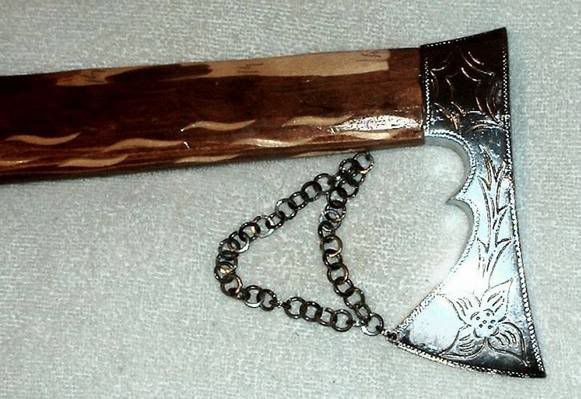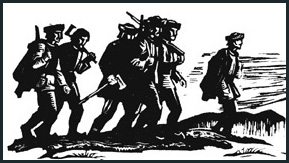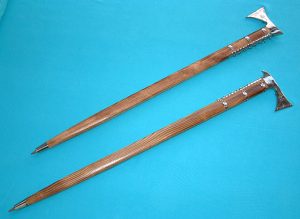When I arrived, the snowfall subsided, and we could light up the forge.
Soon the kids arrived, some really great children celebrating! It shows in the kids if the parents are not half-mad;-). We certainly had fun working with them, even if it was cold. here Volker greets the kids and explains what we will be about.
Then it was party on... even if licce Kevin does not look the part, he enjoyed himself making his first own knife. We made the knives from mild steel. I am not quite comfortable about that, mind you...;-) but I work-hardened the edge some by coldforging. So, the knives were a bit more useful than being utter crap, and the kids used them even for whittling some sticks that were left over from fire building.
...
Since it was that cold, we lit up another fire for warmth. Cozy, huh?;-)
Then, suddenly, the kids were all gone, and I set to work on another project of my own. I forged a spatula and inlaid a piece of 1.2842. Here you can see the first three layers of the billet. I folded it some, and got 24 layers, forged it square, did some torsion on the billet, folded it unto itself, then welded another layer of 1.2842 into the middle for cutting prowess. Did not work as well as last time, and I messed up the direction. In the meantime, it was snowing hard again, my muscles were sore and my back was aching, but a thought occured to me. It was like a song that was hard to describe, but I thought: This is the raven´s song! No clue what and why, but this is what I thought.
A very peculiar atmosphere it was, the roaring forge, the red-hot metal, and the snowstorm blowing and howling. It was hard to work under these circumstances, but I was grateful to be able to experience something most people do not even deem possible. You do not need grand words for it. It was just snow and a forge, and Volker providing me with coffee and cake;-) (Thanks again, bro!). Now and then I paused to take a swig of water, to have a cake and coffee, to chat with Volker and to collect my thoughts and concentration, and then continued to forge the billet into a Hadseax shape, but alas, a portion of the tip had a deep dent in it, don´t know why. So I normalized the blade and ground that part away. Cheating, I know, but what should I do? Then I put a coarse grind on the blade and tempered it.
Then I said goodbye and thankyou to Volker and rode home over snowy trails in the darkness. It was another peculiar experience: The soft powder snow, just high enough to be fun to ride in and low enough to offer plenty of traction, the glittering snowflakes in the light of my headlamp, the howling wind in the vent holes of my helmet... and, apart from the sound of some ducks and geese, and the rustling of little animals in the underbrush, utter and complete silence.
...
At home, I did some finer grinding and some etching with vinegar, citric acid and salt solution... and realized I messed up the pattern... this is the "bad" side of the blade...
...and then I realized the other side looks like a bird´s head, a raven in fact. Can´t make heads nor tails out of that, but that´s okay with me.;-) I never said I wasn´t superstitious, did I?;-).
And YES, THAT IS A WELDING FLAW to the right*grml*ggg*, but it´s just on one side, and this blade will quite certainly see not a big deal of abuse, so I kept it as is.
And since it has two faces anyway, I made a stag antler handle carved with a triquetta and a "valknut" on one side...
... and a raven head on the other.
And as it now has two raven heads, I found the val-knot only appropriate;-). I find this is a nice example of how inspiration works. You do something, and it may be even something going severely awry. And word leads you from word to word, and work leads you from work to work...;-)
















![Die Nackenkammaxt aus dem Hort von Naumburg Gesamtansicht [Landesmuseum für Vorgeschichte Halle]](http://www.museum-digital.de/san/images/201108/29130358843.jpg)
![Die Schafthalsaxt von Freyburg OT Zscheiplitz [31]](http://www.museum-digital.de/san/images/201112/05094722444.jpg)
![Die Schafthalsaxt von Brachwitz Gesamtansicht [31]](http://www.museum-digital.de/san/images/201108/27161508871.jpg)











































